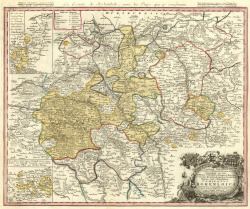Capital Öhringen Established 1450 | Government Monarchy | |
 | ||
Religion Roman CatholicLutheran 1157–70 Albert the Bear (first) 1797–1806 Frederick William IV (last) | ||
Hohenlohe is the name of a German princely dynasty descended from the ancient Franconian Imperial immediate noble family that belonged to the German High Nobility (Hoher Adel). The family was granted the titles of Count (in 1450) and Prince (see below). In 1806 the Princes of Hohenlohe lost their independence and their lands formed part of the Kingdoms of Bavaria and of Württemberg by the Act of the Confederation of the Rhine (12 July 1806). At the time of this mediatization in 1806, the area of Hohenlohe was 1 760 km² and its estimated population was 108,000. The Act of the Confederation of the Rhine deprived the Princes of Hohenlohe of their Imperial immediacy, but did not confiscate their possessions. Until the German Revolution of 1918–19 the Princes of Hohenlohe, as other mediatized families, had important political privileges. They were considered equal by birth (Ebenbürtigkeit) to the European Sovereign houses. In Bavaria, Prussia and Württemberg the Princes of Hohenlohe had hereditary right to sit in the House of Lords. In 1825 the Assembly / Diet of the German Confederation recognized the predicate of "Most Serene Highness" (Durchlaucht) for the heads of the Hohenlohe lines.
Contents
History
An early ancestor was mentioned in 1153 as one Conrad, Lord of Weikersheim. His son Conrad jun. called himself the possessor of Hohlach (Hohenloch or Hohenlohe) Castle near Uffenheim, and the dynasty's influence was soon perceptible between the Franconian valleys of the Kocher, the Jagst and the Tauber Rivers, an area that was to be called the Hohenlohe Plateau. (In 1378, Hohenlohe was sold to the Burggraves of Nuremberg ).
Heinrich I (died 1183) was the first to take the name of Hohenlohe, and in 1230 his grandsons, Gottfried and Conrad, supporters of Emperor Frederick II, founded the lines of Hohenlohe-Hohenlohe and Hohenlohe-Brauneck, names taken from their respective castles. The latter became extinct in 1390, its lands passing later to Brandenburg, while the former was divided into several branches, only two of which, however, Hohenlohe-Weikersheim and Hohenlohe-Uffenheim-Speckfeld, need be mentioned here. Hohenlohe-Weikersheim, descended from Count Kraft I (died 1313), also underwent several divisions, that which took place after the deaths of Counts Albert and George in 1551 being specially important. At this time the lines of Hohenlohe-Neuenstein and Hohenlohe-Waldenburg were founded by the sons of Count George. Meanwhile, in 1412, the family of Hohenlohe-Uffenheim-Speckfeld had become extinct, and its lands had passed through the marriages of its heiresses into other families. George Hohenlohe was archbishop of Esztergom (1418–1423), serving the King Sigismund of Hungary (later also Holy Roman Emperor and King of Bohemia).
In 1450, the Roman King Frederick III granted Kraft of Hohenlohe (died 1472) and his brother, Albrecht, the sons of Elizabeth of Hanau, heiress to Ziegenhain, the title of Count of Hohenlohe and Ziegenhain (Graf von Hohenlohe and zu Ziegenhain) and invested them with the County of Ziegenhain. Actually, the Landgraves of Hesse took the County of Ziegenhain, and the House of Hohenlohe eventually gave up the reference to Ziegenhain.
The Hohenlohe possessions were located in the Franconian Circle, and the family had two voices in its Diet / Assembly (Kreistag).
The Hohenlohe family had six voices in the Franconian College of Imperial Counts (Fränkisches Reichsgrafenkollegium) of the Imperial Diet (Reichstag). The right to vote in the Imperial Diet / Assembly gave a German noble family the status of Imperial State (Reichsstand) and the right to belong to the High Nobility (Hoher Adel).
The existing branches of the Hohenlohe family are descended from the lines of Hohenlohe-Neuenstein and Hohenlohe-Waldenburg, established in 1551 by Ludwig Kasimir (d.1568) and Eberhard (d. 1570), the sons of Count Georg (d.1551). The former of these became Protestant, while the latter remained Roman Catholic.
Of the family of Hohenlohe-Neuenstein, which underwent several partitions and inherited Gleichen in 1631, the senior line became extinct in 1805, while in 1701 the junior line divided itself into three branches, those of Langenburg, Ingelfingen and Kirchberg. Kirchberg died out in 1861, but members of the families of Hohenlohe-Langenburg and Hohenlohe-Ingelfingen are still alive, the latter being represented by the branches of Hohenlohe-Ingelfingen (became extinct in 1960) and Hohenlohe-Öhringen. The Roman Catholic family of Hohenlohe-Waldenburg was soon divided into three branches, but two of these had died out by 1729. The surviving branch, that of Schillingsfürst, was divided into the lines of Hohenlohe-Schillingsfürst and Hohenlohe-Bartenstein; other divisions followed, and the four existing lines of this branch of the family are those of Waldenburg, Schillingsfürst, Jagstberg, and Bartenstein. The family of Hohenlohe-Schillingsfürst possessed the duchy of Ratibor and still owns the principality of Corvey, inherited in 1834.
The Roman Emperors granted the title of Imperial Prince (Reichsfürst) to the Waldenburg line (in 1744) and to the Neuenstein (Öhringen) line (in 1764).
In 1757, the Roman Emperor elevated possessions of the Waldenburg line to the status of Imperial Principality.
In 1772, the Roman Emperor elevated possessions of the Neuenstein and Langenburg lines to the status of Imperial Principality.
Family members
Notable members of the von Hohenlohe family include:
(*) still owned by members of the House of Hohenlohe
Neuenstein line
Waldenburg line
Legion de Hohenlohe
The Legion de Hohenlohe was a unit of foreign soldiers serving in the French Army until 1831, when its members (as well as those of the disbanded Swiss Guards) were folded into the newly-raised French Foreign Legion for service in Algeria.
